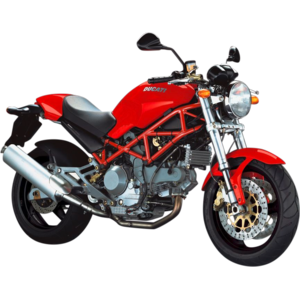Ducati Monster 1000 [2003-2005]: A Timeless Naked Icon Revisited
Introduction
The Ducati Monster 1000, produced between 2003 and 2005, remains a defining chapter in the history of naked motorcycles. With its raw, unfiltered character and iconic design, this generation of the Monster solidified Ducati’s reputation for blending performance with visceral appeal. As I throw a leg over this Italian beast for a modern-era test ride, it’s clear why enthusiasts still hunt for these models—they’re mechanical theater on two wheels. Let’s dissect what makes this generation unforgettable.
Design & Aesthetics: Minimalism with a Menacing Edge
The Monster 1000’s design is a masterclass in purposeful simplicity. The tubular steel trellis frame isn’t just structural art—it’s the bike’s backbone, exposed proudly beneath the tank and seat. The bodywork is stripped to essentials: a muscular fuel tank, a compact tail section, and that signature round headlight staring defiantly ahead. Ducati’s 2003-2005 models leaned into color schemes like metallic grey with red wheels and glossy black/red combos, giving the bike a sinister yet sophisticated vibe.
The riding position is classic naked bike: upright bars, mid-set pegs, and a 800-803 mm (31.5-31.6 inches) seat height that’s accessible for riders of most statures. The cockpit is minimalist—no digital distractions here, just analog gauges that keep you focused on the ride.
Engine & Performance: Air-Cooled Soul, Desmo Heart
At the core of the Monster 1000 beats a 992 cc air-cooled L-twin, a powerplant that’s equal parts charismatic and cantankerous. Ducati’s Desmodromic valve system—a engineering hallmark—eliminates valve float at high RPMs, letting this engine rev freely to its 8,000-8,750 RPM power peak. Output varies slightly across models:
- 84-94 HP (61-68 kW)
- 84-96 Nm (62-71 lb-ft) of torque
Twist the throttle, and the engine responds with a deep, throaty growl that crescendos into a metallic wail. Power builds linearly, with a strong midrange punch that’s perfect for city sprints or carving backroads. The air-cooled design means you’ll feel heat radiating off the cylinders in traffic—a small price for the analog thrill.
The 6-speed gearbox clicks through ratios with mechanical precision, though the dry clutch (on some variants) adds a satisfying clack to every shift. Fuel injection—a rarity in early-2000s nakeds—keeps the engine responsive, though purists might miss the drama of carburetors.
Handling & Dynamics: Lightweight Agility Meets Stability
Weighing between 180-215 kg (396-475 lbs) depending on model year, the Monster 1000 feels shockingly light on its feet. The Showa 43 mm USD fork and Sachs adjustable monoshock (on higher trims) offer a firm yet compliant ride, soaking up bumps while keeping the chassis composed during aggressive cornering.
With a 24-degree rake and 1440 mm (56.7-inch) wheelbase, the Monster strikes a balance between quick steering and highway stability. The 120/70-ZR17 front and 180/55-ZR17 rear tires provide ample grip, letting you lean into turns with confidence. Braking is handled by Brembo discs—dual 320 mm up front—that deliver strong, progressive stopping power.
In urban settings, the Monster darts through traffic like a predator. On twisties, it transforms into a scalpel—flickable, communicative, and begging for another apex.
Competition: How Does It Stack Up?
The early-2000s naked bike segment was fiercely competitive. Here’s how the Monster 1000 fared against rivals:
1. Suzuki SV1000
- Pros: Liquid-cooled V-twin, smoother power delivery, lower maintenance.
- Cons: Lacked the Ducati’s theater and premium components.
- Verdict: A pragmatic choice vs. the Monster’s emotional appeal.
2. Triumph Speed Triple (955i)
- Pros: Brighter top-end power, sharper styling.
- Cons: Heavier, less torque-rich engine.
- Verdict: A British rival with more peakiness, less soul.
3. Honda CB1000R
- Pros: Bulletproof reliability, inline-four scream.
- Cons: Generic personality, heavier chassis.
- Verdict: For those who prefer precision over passion.
The Monster’s Edge: It wasn’t the fastest or cheapest, but nothing matched its rawness and design pedigree. The Desmo engine and trellis frame gave it a cult status competitors couldn’t replicate.
Maintenance: Keeping the Legend Alive
Owning a Monster 1000 is a labor of love. Here’s what to prioritize:
1. Desmodromic Valve Adjustments
- Every 12,000 km (7,500 miles): The Desmo system demands precise valve clearances. Skipping this risks catastrophic engine damage.
- MOTOPARTS.store Tip: Stock up on OEM shim kits or upgrade to aftermarket adjustable rockers.
2. Oil & Fluids
- Oil Changes: Use SAE 10W-40 full synthetic every 5,000 km (3,100 miles). Capacity: ~3.6 liters (0.95 gallons) with filter.
- Brake Fluid: Flush with DOT 4 annually to maintain lever feel.
3. Chain & Sprockets
- The 15/39T sprocket combo and 100-link chain wear quickly under hard riding.
- Upgrade Suggestion: Fit a DID X-ring chain and steel sprockets for longevity.
4. Cooling
- Air-cooled engines run hot. Consider adding an oil cooler or heat-resistant exhaust wrap.
5. Tire Pressures
- Front: 2.1-2.3 bar (30-33 psi)
- Rear: 2.2-2.4 bar (32-35 psi)
Conclusion: Why the Monster 1000 Still Matters
The 2003-2005 Monster 1000 isn’t just a motorcycle—it’s a statement. From its thunderous L-twin to its razor-sharp handling, every ride feels like an event. While modern nakeds offer more tech and refinement, none replicate the rawness and mechanical intimacy of this Ducati.
For owners, MOTOPARTS.store stands ready to keep your Monster roaring. Whether you need performance upgrades, OEM replacements, or that elusive Ducati-specific tool, we’ve got your back. After all, legends deserve eternal care.
Ride hard, service often, and let the Desmo symphony play on.



















